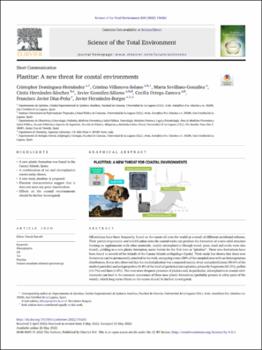Plastitar: A new threat for coastal environments
Fecha
2022Resumen
Oil residues have been frequently found on the coasts all over the world as a result of different accidental releases. Their partial evaporation and solidification onto the coastal rocks can produce the formation of a new solid structure forming an agglomerate with other materials, mainly microplastics (though wood, glass, sand and rocks were also found), yielding to a new plastic formation, name herein for the first time as “plastitar”. These new formations have been found in several of the islands of the Canary Islands archipelago (Spain). Their study has shown that these new
formations can be permanently attached to the rock, occupying even a 56%of the sampled areawith an heterogeneous distribution. Itwas also observed that the studied plastitarwas composed mainly of tar and polyethylene (90.6% of the studied particles) and polypropylene (9.4%of the studied particles) microplastics, primarily fragments (82.5%), pellets
(15.7%) and lines (1.8%). The evermore frequent presence of plastics and, in particular, microplastics in coastal environments can lead to the common occurrence of these new plastic formations (probably present in other parts of the world), which long-term effects on the coasts should be further investigated.






